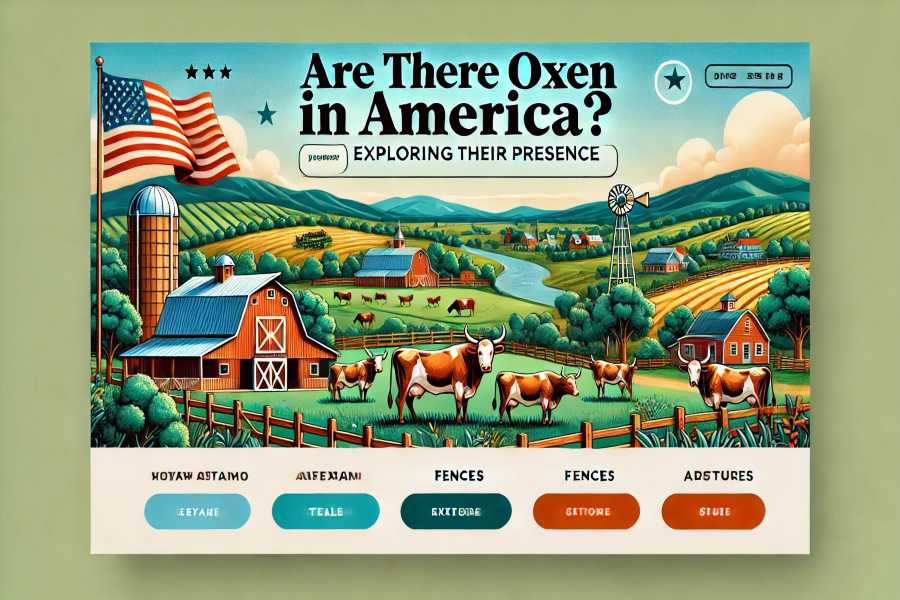
To some, this may sound like a silly question, mainly because it is an age ruled by modern machinery and advanced techniques in farming. Nevertheless, the presence of oxen in America and its implications have deep roots in history, and their relevance is still present today. From their foreseeing prime role in early American agriculture to their continued Cultural use in some regions, oxen have been integral to the nation’s building process. The following comprehensive article shows the historical significance of the oxen in America, defines their roles in modern agriculture, and answers relevant questions concerning the same in the present times. We will examine this issue in depth using historical facts, expert opinions, and firsthand information. Whether you are simply interested or a history and agriculture student, this article will provide important insights into the question: Are there oxen in America?
Are There Oxen In America?
Yes, there are oxen in America. Many years ago, they became necessary for agriculture and transportation. Nowadays, however, they are truly few and far between, even though they are being used in certain parts of the country for specific cultural heritage cultivation methods. They are able to demonstrate part of the cultural heritage, and they do appear to retain some regard among particular farm groups because of their power and stamina.
Historical Significance of Oxen in America
The history of the oxen in America is as old as the colonization period. They were brought to the New World by European settlers who recognized their invaluable contribution toward farming and transportation. Such sturdy animals were needed for felling, clearing forests, plowing through fields, and hauling heavy loads. Oxen were first brought into America by European colonists.
In the 17th to 18th centuries, oxen were thought of as the pillar of American farming. They were able to provide the muscles necessary to turn vast expanses of wilderness into farmland. Their contribution towards farming naturally became limitless; they were used in road and house construction, which helped early American settlements to grow.
In the 19th century, during westward expansion, there was no travel without oxen. They were more preferred for travels than horses because of their strength, endurance, and capacity to survive on sparse vegetation. Oxen-pulled wagons have become symbolic for the pioneers going westward into a new life in a new land.
Their numbers began falling off with the coming of mechanization in the early 20th century when they were superseded by tractors and other machines for most of their farm tasks. The ox never has, however, quite disappeared from the American scene; just alongside the reduced number, it is continuously used in specific regions and particular tasks where its unique capabilities are still appreciated.
Today, interest in oxen is again on the rise, with more farmers going back to traditional methods of farming that focus on sustainability and environmental stewardship. With a minimum ecological imprint, interest in the use of oxen heightens as an alternative to machinery dependent on fossil fuels. In addition to all this, oxen are at the core of cultural and historical reenactments, fairs, and educational programs; thus, they remain alive.
The Role of Oxen in Modern American Agriculture
Traditional Farming Practices: Traditional farming methods still prevail in parts of America. Oxen are primarily retained for plowing fields, more so in small-scale farming and organic farms. Their low impact on soil and the environment makes them sustainable for those farmers who work along the lines of green living.
Logging and Forestry: Also importantly, oxen are used for logging purposes in the forest. Particularly, their ability to move over rough terrain without much destruction to the forest floor is highly valued. In this respect, in countries where sustainable forestry is practiced, oxen play an important role in reducing environmental impact.
Cultural Heritage and Education: Such activities could promote their historical significance but would provide hands-on learning for the new generation. Oxen are part of America’s cultural heritage in historical reenactments, fairs, and educational programs.
Oxen in Homesteading: As the interest in self-sufficiency and homesteading continues to rise, increasing numbers of modern homesteaders are looking to raise and use oxen for their versatility and low cost. They can do some of the much-needed work like plowing and hauling firewood—almost anything for an off-grid kind of existence.
Challenges and Opportunities: Though the use of oxen is not as prevalent as in the past, there are nevertheless opportunities for expansion. Special knowledge and expertise are needed to train and care for oxen. Hence it is a barrier. Nevertheless, with the growing importance of sustainable and organic farming nowadays, the prospects of using oxen in agriculture may resurface.
The Environmental Impact of Using Oxen
In an era where sustainability is a growing concern, the environmental impact of agricultural practices is under scrutiny. Using oxen in farming presents a unique opportunity to minimize the ecological footprint compared to modern machinery. Oxen does not require fossil fuels, reducing carbon emissions associated with farm work. Their natural grazing habits also contribute to soil health, as they help in natural fertilization and weed control.
Moreover, oxen contribute to biodiversity. Unlike heavy machinery that can compact soil and disrupt ecosystems, oxen’s lighter footprint helps maintain soil structure and promote healthy plant growth. In regions practicing sustainable forestry, oxen are preferred for logging because they cause less damage to the forest floor, preserving the natural habitat for wildlife.
The use of oxen aligns with the principles of regenerative agriculture, which focuses on restoring and maintaining healthy ecosystems. By integrating oxen into farming practices, farmers can enhance soil fertility, increase biodiversity, and reduce dependency on synthetic inputs. This approach not only benefits the environment but also improves the resilience and sustainability of agricultural systems.
Furthermore, oxen can play a role in carbon sequestration. As they graze and move through fields, they promote the growth of deep-rooted plants that capture and store carbon in the soil. This natural process helps mitigate climate change by reducing the amount of carbon dioxide in the atmosphere.
The environmental benefits of using oxen in agriculture are significant. They offer a sustainable alternative to mechanized farming, contributing to soil health, biodiversity, and carbon sequestration. As the world seeks solutions to environmental challenges, the role of oxen in promoting sustainable agriculture becomes increasingly relevant.
Oxen in American Culture: A Symbol of Heritage
Historical Reenactments
Oxen is a staple in historical reenactments, bringing history to life for audiences. These events provide a glimpse into the past, showcasing the essential role oxen played in early American society.
Agricultural Fairs
Agricultural fairs across America often feature oxen in various competitions and demonstrations. These events celebrate the agricultural heritage and educate the public about traditional farming practices.
Educational Programs
Many educational programs incorporate oxen to teach students about sustainable farming and historical agriculture. These hands-on experiences foster a deeper understanding and appreciation of America’s agricultural roots.
Homesteading and Self-Sufficiency
In the modern homesteading movement, oxen are valued for their versatility and low cost. They contribute to a self-sufficient lifestyle, providing labor for various tasks and reducing the need for modern machinery.
Cultural Festivals
Oxen are also featured in cultural festivals that celebrate rural life and agricultural traditions. These festivals highlight the importance of oxen in American history and culture, preserving their legacy for future generations.
Conclusion
The presence of oxen in America, both historically and in contemporary times, underscores their enduring significance. From their vital role in early agriculture to their contributions to sustainable farming practices today, oxen have proven to be invaluable assets. They symbolize strength, endurance, and a connection to the land that transcends time. As we continue to seek sustainable solutions in agriculture, the role of oxen may once again become prominent, bridging the past and the future of farming in America.
FAQs:
Q. Are oxen still used in American agriculture?
A. Yes, oxen are still used in certain regions and for specific tasks, particularly in traditional and sustainable farming practices.
Q. What makes oxen suitable for farming?
A. Oxen are valued for their strength, endurance, and ability to work in various terrains. They are also environmentally friendly and cost-effective for small-scale farmers.
Q. How do oxen contribute to sustainable agriculture?
A. Oxen reduces the need for fossil fuels, promotes soil health through natural grazing, and supports biodiversity, making them a sustainable choice for farming.





